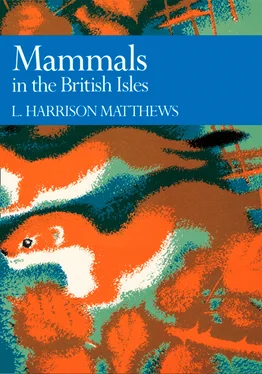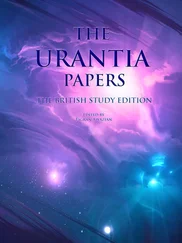Our most detailed knowledge of the composition of the flora and the nature of the climate, at different times during the Pleistocene is, however, derived from the study of fossil pollen, a technique now known as palynology. In addition, a study of peat, freshwater and marine molluscan shells, and of insects, especially the wing covers of beetles, has thrown much light on the changes in climate.
The outer layers of a pollen grain are made of the substance sporopollenin which, unlike the inner cellulose layers, is extremely resistant to the action of chemical changes so that pollen grains are almost indestructible by natural agencies. Vast quantities of pollen released by plants, and especially those species that are wind-pollenated, became mixed with the soil and waters and included in the deposits and sediments. The surface of pollen grains is thrown into a great range of shapes and patterns that are characteristic of, and identify, the different species; the presence and relative quantities of pollen in any sample of Pleistocene deposit therefore show the presence and relative abundance of the plants from which they were derived. So, for example, a predominance of conifer pollen indicates a cool climate, and a preponderance of oak pollen points to a milder climate. There are, naturally, difficulties in using pollen analysis; pollen can be carried great distances by the wind, and the indestructible nature of the pollen coat itself allows pollen from old deposits to be washed out and included in younger ones. Palynology has nevertheless proved to be one of the most valuable tools in reaching an understanding of the changes during the Pleistocene.
Palynology was born in Denmark and was developed with great success in the British Isles by Sir Harry Godwin and his pupils at Cambridge so that the history of the British flora, and with it that of the environmental ecology, is now better known than that of any other area of similar size. 67The earlier work of Zeuner 155on the climate, chronology, and faunal successions of the Pleistocene, not only in the British Isles but throughout the world, was extended in great detail by Charlesworth twelve years later. 33This immense work summarises and reviews world-wide research on the Pleistocene up to 1956, and discusses all the different theories that have been put forward to explain its occurrence and the fluctuations that took place during it.
Charlesworth points out that terrestrial causes such as deformations of the crust of the earth are not sufficient to have brought about glaciations. He favours the theory that long-term variations in the amount of solar radiation reaching the earth were the probable cause, though it may not be possible to prove their occurrence by direct observation. This hypothesis was first made by Simpson, 130who suggested that an increase in solar radiation by raising the world temperature intensified the atmospheric circulation, and brought about glaciation by augmenting the amount of cloud and precipitation. Charlesworth points out that glaciation was probably produced by a number of factors, of which variation in solar radiation was only one, and that meteorological, geological, and astronomical changes ‘all interacting and so delicately balanced that a slight change, such as would be undetected by less than a century of acute observation, might induce great effects.’
As an outcome of recent studies it is now widely accepted 87that major glaciations are due primarily to the positions of the continents resulting from continental drift and the movements of the tectonic plates. Ice ages can only occur when there are land masses in high latitudes on which ice and snow can accumulate – the condition of the earth today, with an Antarctic continent and an Arctic sea surrounded by land. With the continents in these positions the ‘Milankovitch effect’ comes into operation, and small regular changes in the earth’s orbit and orientation towards the sun cause the rhythmic alternation of glaciations and mild interglacial stages through the changes in the amount of heat received by high latitudes. The ‘wobbles’ in the earth’s movements are astronomically predictable, and consequently the sequence of ice ages can be shown to have occurred many times, probably twenty or more, during the Pleistocene. 19Predictions warn that our present interglacial may not last more than another thousand years until it begins to decline into the next glaciation, which, at its peak after some 20,000 years will be more severe than the Devensian.
‘Little ice ages’, such as the cold period that lasted from about 1650 to 1850, occur at more frequent intervals. They are caused by a temporary decline in sunspot activity combined with an increase in terrestrial volcanic activity, which produces a veil of dust in the atmosphere that reduces the solar heat reaching the earth. Major glaciations, however, only occur when the earth periodically ‘wobbles’ to produce the Milankovitch effect.
Whatever the causes of glaciation may be, we may take it as certain that the present mammalian fauna of the British Isles originated after the end of the great Anglian glaciation nearly half a million years ago. Furthermore it seems probable that few species of mammal survived the Devensian glaciation, during which ice covered the northern part of the islands, and the southern parts were subjected to a severe periglacial climate with permafrost producing frost-tundra having little plant cover. At the end of the Devensian the succeeding Flandrian post-glacial stage saw the establishment of the mammalian fauna as we see it today, although it is now reduced by the loss of several species that have been exterminated by man.
During the last hundred and fifty years a host of geologists and palaeontologists, amateur and professional, has collected great quantities of mammalian fossils from the Pleistocene deposits, and has worked on the difficult problems of deducing the composition of the faunas of the various stages. The earlier workers did not appreciate the importance of recording the exact horizons at which they found the fossils, and consequently their specimens give less information than those collected by later workers who adopted a stricter discipline. In addition, much material collected on sea beaches came from strata exposed in the cliffs above, and cannot be accurately assigned to the horizon from which it is derived. Similarly fossil and subfossil bones found in caves have frequently been excavated without recording the precise horizon from which they came. The stratigraphy of cave deposits is complicated by the way in which the fossils were included. The remains from which the fossils are derived were often washed in by floods, or carried in by predators, so that specimens of different provenance are confusingly mixed.
The researches of many workers nevertheless combine to give a picture of the succession of faunas that can be accepted with confidence as reasonably accurate. The results are widely scattered throughout a vast literature, but the Monographs of the Palaeontographical Society 120in which large numbers of mammalian fossils from the Pleistocene have been described and illustrated during the last hundred and thirty years, deserve special notice. Many authorities, too, have gathered the available information together to give an account of the Pleistocene faunas, one of the earliest being Buckland’s ‘Reliquiae Diluvianae’ 27published in 1823, which described fossils from caves and ‘diluvial gravel’ as evidence of ‘the action of a Universal Deluge’. A later classic is Owen’s ‘History of British Fossil Mammals and Birds’ published in 1846, 118and from the nature of the material available necessarily dealing mainly with Pleistocene faunas. In contrast a modern synthesis based on the results of researches supported by the latest technologies such as Stuart’s review, 136shows the complexity of the succession of faunas, and the differences in fauna with the alternation of cold and warm, glacial and interglacial stages. The following summary of events is based in part on this important work.
Читать дальше












